 W
WAirborne Interception radar, Mark IV, or AI Mk. IV for short, was the world's first operational air-to-air radar system. Early Mk. III units appeared in July 1940 on converted Bristol Blenheim light bombers, while the definitive Mk. IV reached widespread availability on the Bristol Beaufighter heavy fighter by early 1941. On the Beaufighter, the Mk. IV arguably played a role in ending the Blitz, the Luftwaffe's night bombing campaign of late 1940 and early 1941.
 W
WAirborne Interception radar, Mark VIII, or AI Mk. VIII for short, was the first operational microwave-frequency air-to-air radar. It was used by Royal Air Force night fighters from late 1941 until the end of World War II. The basic concept, using a moving parabolic antenna to search for targets and track them accurately, remained in use by most airborne radars well into the 1980s.
 W
WThe AI.24 Foxhunter was an airborne radar carried by the Panavia Tornado ADV fighter aircraft and gave it an all-weather, day and night, beyond-visual-range engagement capability.
 W
WAn airborne early warning and control (AEW&C) system is an airborne radar picket system designed to detect aircraft, ships and vehicles at long ranges and perform command and control of the battlespace in an air engagement by directing fighter and attack aircraft strikes. AEW&C units are also used to carry out surveillance, including over ground targets and frequently perform C2BM functions similar to an Air Traffic Controller given military command over other forces. When used at altitude, the radar on the aircraft allows the operators to detect and track targets and distinguish between friendly and hostile aircraft much farther away than a similar ground-based radar. Like a ground-based radar, it can be detected by opposing forces, but because of its mobility and extended sensor range, it is much less vulnerable to counter-attacks.
 W
WAirborne Interception radar, or AI for short, is the British term for radar systems used to equip aircraft in the air-to-air role. These radars are used primarily by Royal Air Force (RAF) and Fleet Air Arm night fighters and interceptors for locating and tracking other aircraft, although most AI radars could also be used in a number of secondary roles as well. The term was sometimes used generically for similar radars used in other countries.
 W
WThe AN/APG-68 radar is a long range Pulse-doppler radar designed by Westinghouse to replace AN/APG-66 radar in the F-16 Fighting Falcon. The AN/APG-68(V)8 and earlier radar system consists of the following line-replaceable units:Antenna Dual Mode Transmitter (DMT) Modular Low-power radio frequency (MLPRF) Programmable signal processor (PSP)
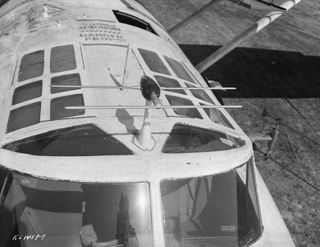 W
WRadar, Air-to-Surface Vessel, Mark II, or ASV Mk. II for short, was an airborne sea-surface search radar developed by the UK's Air Ministry immediately prior to the start of World War II. It was the first aircraft mounted radar of any sort to be used operationally. It was widely used by aircraft of the RAF Coastal Command, Fleet Air Arm and similar groups in the United States and Canada. A version was also developed for small ships, the Royal Navy's Type 286.
 W
WRadar, Air-to-Surface Vessel, Mark III, or ASV Mk. III for short, was a surface search radar system used by RAF Coastal Command during World War II. It was a slightly modified version of the H2S radar used by RAF Bomber Command, with minor changes to the antenna to make it more useful for the anti-submarine role. It was Coastal Command's primary radar from the spring of 1943 until the end of the war. Several improved versions were introduced, notably the ASV Mark VI, which replaced most Mk. IIIs from 1944 and ASV Mark VII radar, which saw only limited use until the post-war era.
 W
WThe Automatic Gun-Laying Turret (AGLT), also known as the Frazer-Nash FN121, was a radar-directed, rear gun turret fitted to some British bombers from 1944. AGLT incorporated both a low-power tail warning radar and fire-control system, which could detect approaching enemy fighters, aim and automatically trigger machine guns – in total darkness or cloud cover if necessary. The radar warning and fire-control system itself was commonly known by the code names Village Inn and "Z Equipment", as well as the serial number TR3548.
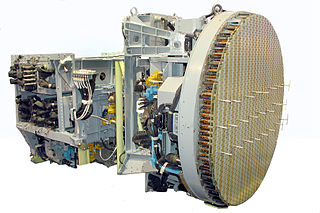 W
WThe Bars (Leopard) is a family of Russian all-weather multimode airborne radars developed by the Tikhomirov Scientific Research Institute of Instrument Design for multi-role combat aircraft such as the Su-27 and the MiG-29.
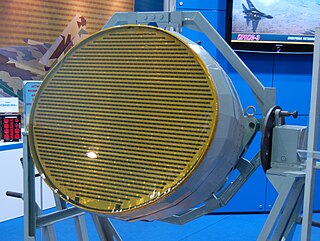 W
WN036 Byelka is an advanced active electronically scanned array radar system developed by Tikhomirov NIIP for the fifth generation Sukhoi Su-57 fighter aircraft.
 W
WThe IAI EL/W-2090 is an airborne early warning and control (AEW&C) radar system developed by Israel Aerospace Industries (IAI) and Elta Electronics Industries of Israel. Its primary objective is to provide intelligence to maintain air superiority and conduct surveillance. The system is currently in-service with the Indian Air Force.
 W
WThe Erieye radar system is an Airborne Early Warning and Control System (AEW&C) developed by Saab Electronic Defence Systems of Sweden. It uses active electronically scanned array (AESA) technology. The Erieye is used on a variety of aircraft platforms, such as the Saab 340 and Embraer R-99. It has recently been implemented on the Bombardier Global 6000 aircraft as the Globaleye.
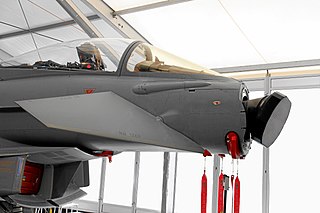 W
WThe Euroradar Captor is a next-generation mechanical multi-mode pulse Doppler radar designed for the Eurofighter Typhoon. Development of Captor led to the Airborne Multirole Solid State Active Array Radar (AMSAR) project which eventually produced the CAESAR, now known as Captor-E.
 W
WThe Ferranti Blue Fox was a British multi-role airborne radar designed and built for the Royal Navy by Ferranti Defence Systems in the late 1970s. It had a mixed record in service, and was replaced by the more capable Blue Vixen.
 W
WFuG 25a Erstling was an identification friend or foe (IFF) transponder installed in Luftwaffe aircraft starting in 1941 in order to allow German Freya radar stations to identify them as friendly. The system was also used as a navigation transponder as part of the EGON night bombing system during 1943 and 1933. It was the second IFF system to be used, replacing the FuG 25 Zwilling.
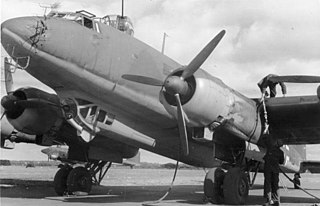 W
WThe FuG 200 "Hohentwiel" was a low-UHF band frequency maritime patrol radar system of the Luftwaffe in World War II. It was developed by C. Lorenz AG of Berlin starting in 1938 under the code name "Hohentwiel", an extinct volcano in the region of Baden-Württemberg in southern Germany. The device had originally been entered into a design contest held by the Luftwaffe for the new FuMG 40L. When competitor Telefunken won that contract with its "Würzburg radar" in 1939, the device was shelved.
 W
WThe FuG 240 "Berlin" was an airborne interception radar system operating at the "lowest end" of the SHF radio band, which the German Luftwaffe introduced at the very end of World War II. It was the first German radar to be based on the cavity magnetron, which eliminated the need for the large multiple dipole-based antenna arrays seen on earlier radars, thereby greatly increasing the performance of the night fighters. Introduced by Telefunken in April 1945, only about 25 units saw service.
 W
WGlobalEye is a multi-role airborne early warning & control (AEW&C) platform from Swedish defence and security company Saab. GlobalEye consists of a suite of sensors using Saab's Erieye ER radar and mission system, installed in the Bombardier Global 6000 long-range business jet.
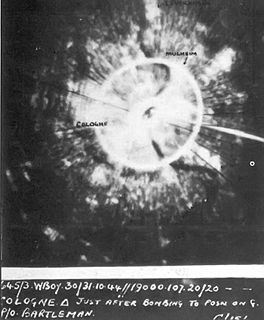 W
WH2S was the first airborne, ground scanning radar system. It was developed for the Royal Air Force's Bomber Command during World War II to identify targets on the ground for night and all-weather bombing. This allowed attacks outside the range of the various radio navigation aids like Gee or Oboe, which were limited to about 350 kilometres (220 mi). It was also widely used as a general navigation system, allowing landmarks to be identified at long range.
 W
WH2X, officially known as the AN/APS-15, was an American ground scanning radar system used for blind bombing during World War II. It was a development of the British H2S radar, the first ground mapping radar to be used in combat. It was also known as the "Mickey set" and "BTO" for "bombing through the overcast" radar.
 W
WIrbis-E is a Russian multi-mode, hybrid passive electronically scanned array radar system developed by Tikhomirov NIIP for the Su-35 multi-purpose fighter aircraft. NIIP developed the Irbis-E radar from the Bars radar system used on Sukoi SU-30MK aircraft.
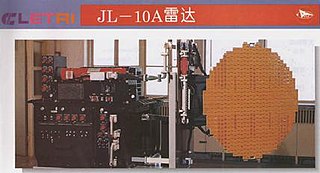 W
WThe JL-10A airborne radar is a highly digitized pulse-Doppler radar with slotted planar array developed for the People's Liberation Army Air Force (PLAAF) as a replacement for the older Type 232H radar currently employed by the Chinese air force. The radar is built to MIL-STD-1553 standard so it is compatible with western electronics and weaponry. Originally, the radar is capable of simultaneously tracking 10 targets and engaging 2 of the 10 tracked when using semi-active radar homing air-to-air missiles, or 4 of the 10 tracked when using active radar homing air-to-air missiles.
 W
WThe Lichtenstein radar was among the earliest airborne radars available to the Luftwaffe in World War II and the first one used exclusively for air interception. Developed by Telefunken, it was available in at least four major revisions, called FuG 202 Lichtenstein B/C, FuG 212 Lichtenstein C-1, FuG 220 Lichtenstein SN-2 and the very rarely used FuG 228 Lichtenstein SN-3.. The Lichtenstein series remained the only widely deployed airborne interception radar used by the Germans on their night fighters during the war — the competing FuG 216 through 218 Neptun mid-VHF band radar systems were meant as a potentially more versatile stop-gap system through 1944, until the microwave-based FuG 240 "Berlin" could be mass-produced; the Berlin system was still being tested when the war ended.
 W
WMonica was a range-only tail warning radar for bombers, introduced by the RAF in June 1942. Officially known as ARI 5664, it operated at frequencies of around 300 MHz. The system was also used by the US Army Air Forces, under the name AN/APS-13, and the nickname Archie.
 W
WThe Multi-role Electronically Scanned Array (MESA) is a surveillance radar system for the Boeing 737 AEW&C airborne early warning and control aircraft. The radar is produced by Northrop Grumman.
 W
WNeptun ('Neptune') was the code name of a series of low-to-mid-VHF band airborne intercept radar devices developed by Germany in World War II and used as active targeting devices in several types of aircraft. They were usually combined with a so-called "backwards warning device", indicated by the addition of the letters "V/R". Working in the metre range, Neptun was meant as a stop-gap solution until scheduled SHF-band devices became available.
 W
WThe RBE2 is a multirole radar developed during the 1990s for the French Dassault Rafale combat aircraft.
 W
WThe RP-21 Sapfir was a radar system, developed by the Soviet Union for use in the updated MiG-21PF fighter, and later versions of the MiG-21.
 W
WSearchwater is a maritime surveillance radar developed by Thorn EMI under project P1149. This type of radar has been in service with the Royal Air Force Hawker Siddeley Nimrod aboard the MR2 variant since the 1970s.
 W
WSHORAN is an acronym for SHOrt RAnge Navigation, a type of electronic navigation and bombing system using a precision radar beacon. It was developed during World War II and the first stations were set up in Europe as the war was ending, and was operational with Martin B26 Marauders based in Corsica, and later based in Dijon and in B26's given to the South African Airforce in Italy. The first 10/10 zero visibility bombing was over Germany in March 1945. It saw its first combat use in the B-25, B-26 and B-29 bomber aircraft during the Korean War.
 W
WSide-looking airborne radar (SLAR) is an aircraft- or satellite-mounted imaging radar pointing perpendicular to the direction of flight. A squinted (nonperpendicular) mode is possible also. SLAR can be fitted with a standard antenna or an antenna using synthetic aperture.
 W
WTerrain-following radar (TFR) is a military aerospace technology that allows a very-low-flying aircraft to automatically maintain a relatively constant altitude above ground level and therefore make detection by enemy radar more difficult. It is sometimes referred to as ground hugging or terrain hugging flight. The term nap-of-the-earth flight may also apply but is more commonly used in relation to low-flying military helicopters, which typically do not use terrain-following radar.
 W
WThe Russian BRLS-8B "Zaslon" (Barrier) is an all-weather multimode airborne radar developed between 1975 and 1980 by the Tikhomirov Scientific Research Institute of Instrument Design as part of the weapons control system of the MiG-31 supersonic interceptor. The NATO codename for the radar is Flash Dance with the designations "SBI-16", "RP-31", "N007" and "S-800" also being associated with the radar.
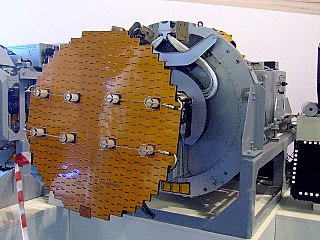 W
WThe Zhuk are a family of Russian all-weather multimode airborne radars developed by NIIR Phazotron for multi-role combat aircraft such as the MiG-29 and the Su-27. The PESA versions where also known as the Sokol.